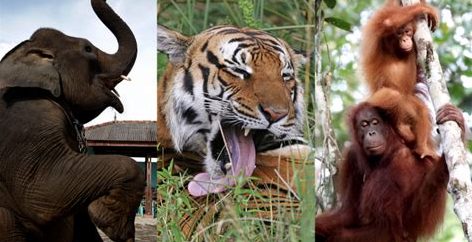CASA BLOGS

NATURE IS INVINCIBLE, NOT EXTINCTION
Sudan, the last male northern white rhinoceros died this year in Kenya, leaving his species on the brink of extinction. According to the World Economic Forum(WEF) report, 19 animal species are critically endangered in the world including the South China Tiger and the Orangutan.

By Prerna Lall
Interns – CASA Communications
In the last decade, Western Black Rhinoceros and Pinta Island Tortoise have disappeared from the earth. More than 26,000 species are threatened with extinction, that is more than 27% of all the assessed species by the International Union for Conservation of Nature (IUCN).
 India, a megadiverse country with only 2.4% of the world’s land area, accounts for 7-8% of all recorded species, including over 45,000 species of plants and 91,000 species of animals. As per the quantitative evaluation done by the IUCN, there are 57 critically endangered species of animals in India including the Gyps vulture, Indian Tiger and Olive Ridley Turtle.
India, a megadiverse country with only 2.4% of the world’s land area, accounts for 7-8% of all recorded species, including over 45,000 species of plants and 91,000 species of animals. As per the quantitative evaluation done by the IUCN, there are 57 critically endangered species of animals in India including the Gyps vulture, Indian Tiger and Olive Ridley Turtle.
It shouldn’t come as a surprise that a major cause for species extinction is human beings. We love animals only to pet and poach them for our pleasure. Habitat loss, degradation, fragmentation and hunting are the greatest eliminators of terrestrial species. Deforestation happens so rapidly that the species do not have time to adapt to their “new forced environment” and are lost in the process. Studies estimate that 25% of the world’s current animal and plant species could be gone by 2050, and 50% could be gone by the end of the century with the current extinction rate.
How does species extinction bother us? When the American Bison got extinct, the entire tribe in the United States which was dependent on it had to shift their existence for survival. We live in an ecosystem, an environment where species depend on each other for survival. When a species gets wiped off the planet, it upsets the balance of nature. It will take at least 5 million years for speciation to rebuild the biodiversity we are likely to destroy during this century, indicates a study.
India realised the importance of conserving the environment in 1865 with the introduction of the first Indian Forest Act. Since then several policies have been adopted by the Government of India including The Wildlife (Protection) Amendment Act, 2006 and National Wildlife Action Plan (2002-2016). In order to protect endangered animals in India like the Indian tiger and the Gharial, the government implemented projects like Save the Tiger and Crocodile Conservation Project.
In whatever way we may look at this, animal extinction touches us, not forgetting that we are also animals. We cannot pretend or rather ignore species extinction, yet our actions and activities do contribute towards it. If we don’t address this problem seriously then we are going to be victims of this extinction that we’re at fault for.
Image source: www.ibtimes.co.uk
 Previous Blog Post #MeToo #TimesUp – The 21st Century Women Mutiny
Previous Blog Post #MeToo #TimesUp – The 21st Century Women Mutiny Filariasis: Battling Superstition WITH CARE
Filariasis: Battling Superstition WITH CAREFeatured Post

Empowering Rural Education in India:
14 Mar 2024
Introduction: In the vast tapestry of India, education is the key to unlocking the door to a brighter future. However, the challenge of providing quality education to the rural parts of the country persists. In this blog post, we will delve into the crucial role that Non-Governmental Organizations (NGOs) play in bridging the educational gap […]

Empowering the Future: Disaster Management Training for School Children in Disaster-Prone Areas
22 Feb 2024
Introduction: In the face of increasing natural disasters worldwide, it becomes imperative to equip our younger generation with the knowledge and skills necessary to handle emergency situations. Children, being one of the most vulnerable groups during disasters, can greatly benefit from disaster management training. This blog explores the significance of imparting such training, with a […]

Empowering Women: Transforming Lives Through Sustainable Livelihoods in Rural India
16 Feb 2024
Introduction: In the heart of rural India, a silent revolution is taking place as women embrace newfound opportunities for sustainable livelihoods. This transformation not only uplifts individual lives but also contributes to the overall development of communities. At [Your Organization’s Name], we are committed to driving positive change by providing women in rural India with […]


